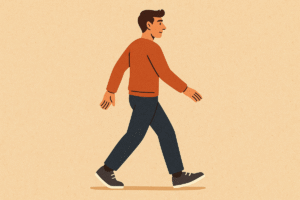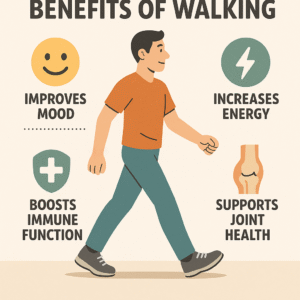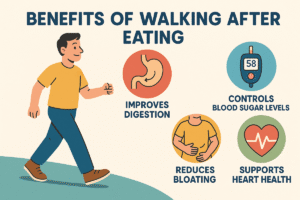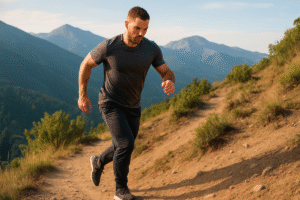Ever catch yourself wondering, “Is walking really enough to change my health?” Like… can something that simple actually burn fat, tone your body, Spoiler alert: yep. And it’s way more powerful than most people think.
Let’s dive into why walking isn’t just a stroll through the park. It’s a fat-burning, mood-lifting, metabolism-waking game changer. Oh, and don’t worry — no equipment, no gym membership, no BS.
1. Why Walking Is the Most Underrated Workout

You’ve seen it. Everyone’s talking about the latest HIIT craze, CrossFit, some influencer with bands on a beach. Meanwhile, walking is just vibing in the background, quietly being one of the most powerful, low-impact exercises ever.
Here’s the deal:
-
It’s free.
-
You can do it literally anywhere.
-
You don’t need fancy leggings or a personal trainer screaming in your ear.
Why it works?
When you walk, you’re not just “moving” — you’re engaging your whole body, increasing circulation, and burning a surprising amount of calories, especially if you do it right.
2. How Many Steps a Day to Lose Weight?
This question is everywhere — and for good reason. People wanna know if 10,000 steps is the magic number. So let’s clear the air.
General Rule of Thumb:
| Goal | Daily Steps |
|---|---|
| Maintain weight | 5,000 – 7,500 |
| Lose weight | 8,000 – 12,000 |
| Accelerated fat loss | 12,000 – 15,000+ |
👉 Sweet spot: Start aiming for 10,000 steps a day if you’re serious about fat loss. That’s usually about 4 to 5 miles, depending on your stride.
And yep, walking for weight loss is 100% real. The more consistent you are, the more those steps start showing up on the scale — or better yet, in your jeans.
3. The Massive Health Benefits of Walking

Let’s get nerdy. Because the health benefits of walking? Unreal. Here’s a breakdown of what a regular walking habit can do for you:
Physical Benefits:
-
Burns calories and body fat
-
Reduces belly fat
-
Tones legs, core, and glutes
-
Lowers blood pressure
-
Reduces risk of heart disease, stroke, and type 2 diabetes
Mental Benefits:
-
Slashes stress and anxiety
-
Boosts serotonin and dopamine (hello, good vibes)
-
Improves sleep quality
-
Clears brain fog and sharpens focus
And the best part? No side effects except maybe falling in love with the outdoors.
4. 45 Minutes a Day? Here’s What Happens
What if you committed to just walking 45 minutes a day for the next 30 days? Here’s the tea:
Week 1:
-
Your body starts adapting
-
You feel more energized
-
Appetite becomes more balanced
Week 2–3:
-
Weight begins to shift (especially if paired with clean eating)
-
You sleep better
-
Your legs start looking leaner
Week 4:
-
You feel lighter, sharper, and more in control
-
Jeans might fit better (or looser 😏)
-
Your heart health, mood, and metabolism all get a boost
45 minutes a day is kind of the sweet spot. It’s long enough to burn fat and not so long that it feels like a chore.
5. The Magic of Walking After Eating

Here’s a trick not enough people talk about: walking after meals. Especially dinner.
When you go for a 10–15 minute walk after eating, magic happens:
-
Blood sugar levels stabilize
-
Digestion improves
-
Fat storage decreases
-
You avoid that nasty food coma
In fact, studies show it can cut post-meal blood sugar spikes in half.
Pro tip: Walk around the block after dinner instead of crashing on the couch. You’ll thank yourself.
6. Get More From Your Walk: Incline Walking

Wanna turn your walk into a leg-sculpting, heart-pumping machine? Add incline.
Benefits of incline walking:
-
Increases calorie burn by 50%+
-
Activates glutes, hamstrings, and calves
-
Builds muscle tone and definition
-
Less impact than running but more intense than flat walking
Even a 5% incline on a treadmill or natural hill will light. you. up.
Do it 2–3 times a week, and you’ll notice serious body changes.
7. Reverse Walking? Sounds Weird, Works Wonders
Yep, walking backward is a real thing. And it’s not just for football drills.
Benefits of reverse walking:
-
Improves balance and coordination
-
Strengthens knees and joints
-
Hits muscles you don’t normally use
-
Enhances cognitive function (your brain works harder)
You can do it in a hallway, gym, or safe outdoor path. Start slow — and maybe not during rush hour traffic.
8. The No-Equipment Challenge: Start Here
Alright, ready to put all this into action? Here’s your 7-day walking challenge, no equipment needed.
Day 1: Walk 6,000 steps. Flat ground. Easy pace.
Day 2: Walk 8,000 steps. Add hills or stairs.
Day 3: 45-minute walk post-dinner.
Day 4: 10,000 steps. Include 5 mins backward walking.
Day 5: Incline walk (treadmill or hill) for 30 mins.
Day 6: Walk 12,000 steps. Listen to a podcast.
Day 7: 45-minute nature walk. Reflect. Reset.
No gym. No gear. Just you and your steps.
9. Frequently Asked Questions (FAQ)
Q: Can walking really help me lose weight?
A: Absolutely. Especially if you’re consistent and walking in the fat-burning zone — that’s usually a brisk pace, around 3–4 mph.
Q: When’s the best time to walk?
A: Anytime. But morning walks rev up your metabolism, and post-meal walks help digestion.
Q: Do I need special shoes?
A: Comfort is key. Supportive sneakers are ideal, but don’t overthink it. Just don’t wear flip-flops or dress shoes.
Q: Is walking better than running?
A: For many people, yes. Less impact on joints, easier to stick with, and still burns hella calories — especially on an incline.
10. Final Thoughts: Walk This Way
You don’t need a gym pass. You don’t need a six-week shred program. You don’t even need to break the bank on supplements.
You just need to walk.
Walking is your secret weapon — your stealthy, reliable, no-excuses tool to get healthier, lose weight, feel better, and reconnect with your body. It’s time to stop underestimating it.
So… lace up, grab a bottle of water, and walk your way to a better you. Because sometimes the simplest path forward is the one right under your feet.
Sources & Citations
-
Mayo Clinic – Walking: Trim your waistline, improve your health – (2023)
-
Healthline – How Many Steps a Day to Lose Weight – (2024)
-
Harvard Health – Walking for Health – (2023)
-
PubMed – Postprandial Walking and Blood Glucose Levels – (2021)
-
CDC – Physical Activity Basics – (2022)
